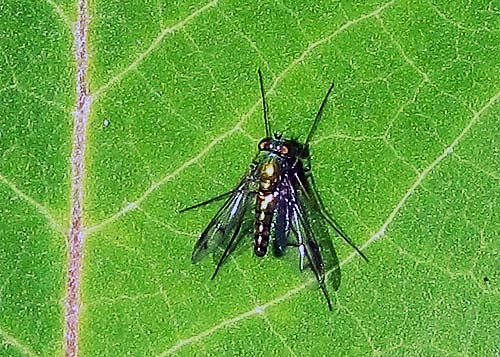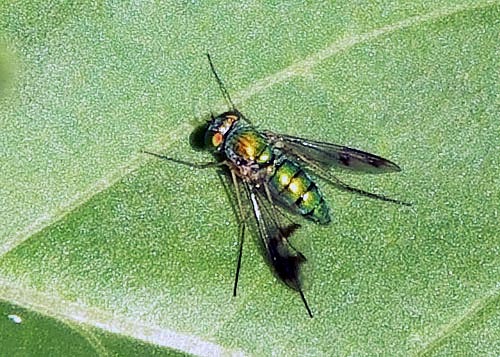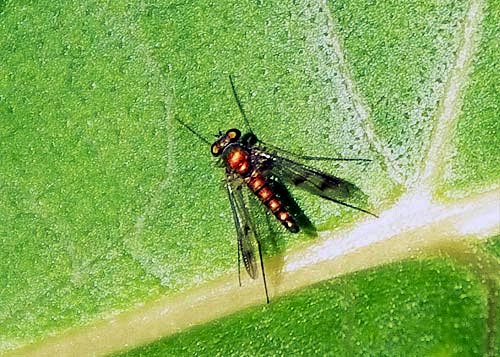Howdy, BugFans,
Every summer the BugLady stalks these jumpy little guys, trying to get one to stop skating around the leaf tops long enough to get its portrait made. If there is a market for out-of-focus pictures of long-legged flies, the BugLady has cornered it.
Long-legged Flies
If you look at the pictures of long-legged flies on bugguide.net, many are accompanied by the photographer’s request for identification, preferably down to species. If you look at the responses from the experts, you’ll see a lot of barely-concealed mirth, of the “You’ve got to be kidding” and the “Wasn’t this group completely reorganized recently?” variety. They’ll concede family—Dolichopodidae—but not much else; positive identifications seem to depend on microscopic scrutiny of the males’ often-prominent “naughty-bits.” Dolichopodidae comes from the Greek dolichos (long) and podos (foot). The BugLady guesses that these long-legged flies pictured here are in the genus Condylostylus, but she wouldn’t bet the farm on it. About three long-legged flies could perch on the word “Dolichopodidae” simultaneously.
Some numbers:
- Insects are the biggest group (Class) under the Arthropod umbrella&mdsh;cold-blooded, jointed-legged critters—along with spiders, horseshoe crabs, scorpions, lobsters and such. More than 80% of the animal species we share the earth with today are arthropods.
- Around 1.5 million species of insects have been described/identified, and some scientists guess that at least another 1.5 million are waiting in line (or under tree bark or soil or in caves or at mountain tops, or—you get the picture) for recognition. 7,000+ new insect species are identified each year.
- Depending on whose book you read, there are about 91,000 kinds of insects in North America (north of Mexico).
- 40% of all insect species are beetles (400,000 species); one-quarter of ALL life forms (plant, animal, etc.) are beetles!
- Flies are a big bunch, too. About 153,000 species of flies have been described, and again, an equal number may be hiding in the bushes. Some 17,000 fly species live in the U.S. and Canada combined.
In that context, it’s amazing to find out that there are around 7,000 species in the long-legged fly family worldwide (600 species in just the single genus Dolichopus), and that 1,300 species live in North America! They’re a big bunch of small (¼”), big-eyed, often metallic (and, yes—long-legged) flies.
Look for long-legged flies (LLFs) on leaves in dappled shade near gardens, grasslands, woodlands, and wetlands:
- There, they consume their soft-bodied, invertebrate brethren—primarily other flies, but also aphids, springtails, silverfish, thrips, insect larvae, and mites (there are some scavengers in the family, too). Besides running across leaves in search of prey (and to avoid the BugLady’s camera), some LLFs can skate across the water searching for mosquito larvae, which they pluck from below the surface film. LLFs consume carbs in the form of honeydew, left behind on leaf surfaces by the various bugs that excrete it.
- There, the adults mate after a slow-motion courtship dance. Their signals are visual. An alternate translation of the word Dolichopodidae, put forth in Kaufman and Eaton’s Field Guide to Insects of North America, is “decorated foot.” Scales, disks, flag-like hairs, or fans adorn the legs of males of many species, and they flash these at female LLFs in a ritual called “badge-waving.” Males of other LLF species perform their courtship dances with patterned wings, and there are reports of males dancing in swarms, like midges. In LLFs, size does matter. Research suggests that females choose larger males; adult size is related to the food available during the male’s former life as a larva.
- There, their (not-very-well-studied) larvae live, along a continuum of dampness ranging from moist soil to aquatic habitats. The maggots pupate in cocoons they build by gluing together tiny pieces of soil.
LLFs have been around since the Cretaceous Period (65 to 144 millions years ago), when they had a tendency to wander into and get stuck in amber. Their larvae live, along a continuum of dampness ranging from moist soil to aquatic habitats.
The Bug Lady


